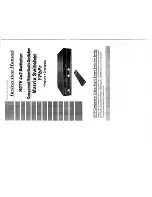
Chapter 4: Web management
NS3550-8T-2S Industrial Managed Switch User Manual
121
Object
Description
AdminEdge
Controls whether the operEdge flag should start as set or cleared (the
initial operEdge state when a port is initialized).
AutoEdge
Controls if the bridge should enable automatic edge detection on the
bridge port. This allows operEdge to be derived from BPDUs received
on the port.
Restricted Role
If enabled, causes the port not to be selected as root port for the
CIST or any MSTI, even if it has the best spanning tree priority
vector. Such a port will be selected as an alternate port after the root
port has been selected. If set, it can cause a lack of spanning tree
connectivity. It can be set by a network administrator to prevent
bridges external to a core region of the network and influence the
spanning tree active topology, possibly because those bridges are
not under the full control of the administrator. This feature is also
known as
Root Guard
.
Restricted TCN
If enabled, causes the port not to propagate received topology
change notifications and topology changes to other ports. If set, it can
cause temporary loss of connectivity after changes in a spanning
tree's active topology as a result of persistently incorrect learned
station location information. It is set by a network administrator to
prevent bridges external to a core region of the network, causing
address flushing in that region, possibly because those bridges are
not under the full control of the administrator or the physical link state
of the attached LANs transits frequently.
BPDU Guard
If enabled, causes the port to disable itself upon receiving valid
BPDU's. Contrary to the similar bridge setting, the port
Edge
status
does not effect this setting.
A port entering error-disabled state due to this setting is subject to the
bridge port error recovery setting as well.
Point-to-point
Controls whether the port connects to a point-to-point LAN rather
than a shared medium. This can be automatically determined, or
forced either true or false. Transitions to the forwarding state is faster
for point-to-point LANs than for shared media.
Buttons
• Click
Save
to save changes.
• Click
Reset
to undo any changes made locally and revert to previously saved
values.
By default, the system automatically detects the speed and duplex mode used on each
port, and configures the path cost according to the following values. Path cost “0” is
used to indicate auto-configuration mode. When the short path cost method is selected
and the default path cost recommended by the IEEE 8021w standard exceeds 65,535,
the default is set to 65,535.
Recommended STP path cost range
By default, the system automatically detects the speed and duplex mode used on each
port and configures the path cost according to the values shown below. Path cost “0” is
used to indicate auto-configuration mode. When the short path cost method is selected
















































